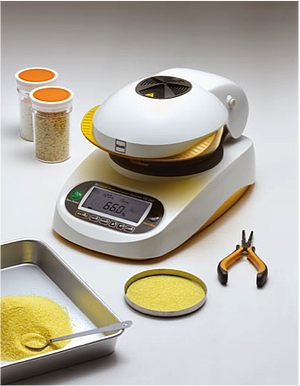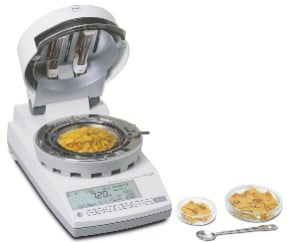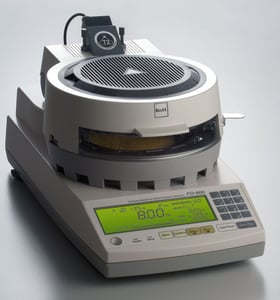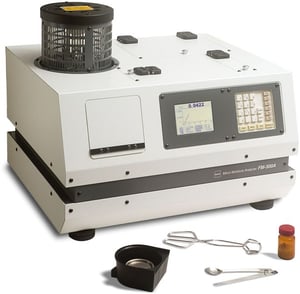 Moisture balances can be incredibly useful instruments—in labs, research facilities, the pharmaceutical industry, the paper industry, with food, plastics, chemicals— and beyond.
Moisture balances can be incredibly useful instruments—in labs, research facilities, the pharmaceutical industry, the paper industry, with food, plastics, chemicals— and beyond.
These easy-to-operate, helpful instruments rely on the “loss on drying” (LOD) method to determine the amount of moisture in a given sample. Loss on drying refers to the loss of weight (expressed as a percentage) after water and other volatile substances are driven from a product, usually by heating it.
The loss on drying method is a primary method of determining moisture content; it can measure the moisture levels of practically any kind of sample without calibration. They are great in controlled environments like a lab or research facility but are remarkably simple to use, making them ideal for any skill level. Because of this, moisture balances and LOD moisture readings are a common way to determine moisture levels, even near process lines or at receiving locations.
In some cases, moisture balances can provide more accurate moisture readings than a universal moisture meter or manually finding the loss on drying percentage. Moisture balances are especially useful in research and development because the product “recipe” can change from test to test, and a moisture balance can give you an accurate moisture content reading without the need for a new calibration every time you change your recipe.
So how can you tell which moisture balance is the right fit for your needs? Here’s a quick side-by-side view of each moisture balance:
The Innovative Moisture Balance
If you’re on a budget but need a reliable, high-speed moisture balance, you should consider the FD660 Innovative Moisture Balance. The FD660 uses an organic carbon infrared heating element but costs the same as many moisture balances that use a heating lamp or ceramic heating element.
Don’t be mistaken by the budget, though; this moisture balance has many features that other companies only offer in their pricey moisture balance models.
Organic carbon heaters are more efficient and can provide you with faster results. It provides infrared rays that are 2 times stronger than halogen systems. You can conduct more tests in one day without the need for additional instruments to get the job done. In addition, the service life has been shown to be 7,000 hours, which is 4 times of a comparable infrared lamp. The FD660 is also incredibly easy to use; you put the sample into the test tray, close the lid and press a button. That’s it!
This makes it a perfect entry-level moisture balance in budget as well as operation.
The Advanced Moisture Balance
The FD720 Advanced Moisture Balance uses the power of quartz to heat samples, which will last five to 10 times longer than halogen or infrared heat sources. It is simple and safe enough to use on any liquid, paste or solid compound, including pharmaceuticals, pulp and paper, and polymers. The FD720 comes with seven measurement modes and 10 product drying programs.
The core of the scale is formed by a single-unit aluminum UniBlock weight sensor. This sensor provides excellent responsiveness, temperature characteristics, and shock resistance. This UniBloc sensor ensures excellent reliability in moisture content and measurements, even over extended use.
The FD720 can measure a sample up to 120g, meaning that samples are more likely to be representative of heterogeneous samples (imaging a breakfast bar or the like), without sample preparation. The 130mm (5") diameter weigh pan allows samples to be spread more than competitive units with small dishes. This accelerates testing and provides more uniform drying.
The FD720 also comes equipped with a sizable memory, storing 100 test results and allowing for data output to printers or PCs for versatility and traceability, making it a great option to use in any lab where the demand for numerous tests and comparisons is necessary.
The Dual Temperature Control Advanced Moisture Balance
At the top of the line of moisture balances in the Kett instrument arsenal is the FD800 Dual Temperature Control Advanced Moisture Balance. This moisture balance is controlled by a dual temperature sensor for ideal, even drying without scorching, even on the most difficult of samples for loss on drying moisture measurement techniques.
Other moisture balances monitor the temperature of the drying chamber. The FD800, on the other hand, measures both the ambient temperature and the temperature of the sample, making it the standard in research and development facilities where samples need to be carefully and accurately dried.
When drying samples, it can monitor the surface temperature of each sample and can be programmed to increase the instrument drying until the surface temperature reaches a set level, then drop the drying temperature to dry the sample quickly while avoiding burning. Use in this way can further accelerate throughput, while ensuring each test is accurately completed with out scorching the sample and over-calculating the moisture content.
Print test parameters, track moisture level changes, and enjoy multiple moisture measurement modes to adapt to different kinds of samples:
- Auto
- Timed
- High-speed
- Low-speed
- Stepped
- Predictive
It has been used with powders, cereals, other foods, pastes, liquids and particulates, but its uses don’t stop there. With precise management of the temperature of your sample and all the other bells and whistles, there’s not much the FD800 can’t do, making it ideal for research and development across all industries.
Each customer we work with has different needs, which means there’s probably a specific moisture balance to accomplish your goals while staying within your price point. At Kett, we want to ensure you end up with the perfect instrument to meet your team’s needs so you’re completely thrilled with your moisture balance.
Can we help you choose the right moisture balance? Contact us today, and together we’ll figure it out!


